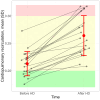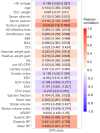Cardiopulmonary recirculation in patients with chronic heart failure and preserved left ventricular ejection fraction: the "Monday Morning Phenomenon"
- PMID: 40890613
- PMCID: PMC12400737
- DOI: 10.1186/s12882-025-04431-6
Cardiopulmonary recirculation in patients with chronic heart failure and preserved left ventricular ejection fraction: the "Monday Morning Phenomenon"
Abstract
Background: Cardiopulmonary recirculation (CPR) is a known risk factor for heart failure (HF). Typically, the assessment is performed on the interdialytic day. Hemodialysis (HD) sessions can induce significant hemodynamic changes, which may be important for patients with HF and preserved ejection fraction (EF), in whom the risk may be underestimated.
Objective: To evaluate the dynamics of CPR due to a HD session following a long interdialytic gap in patients with HF and preserved EF.
Methods: The prospective cohort single-arm study included 20 adult HD patients who met the inclusion criteria: EF ≥ 50%, NYHA I-II, AVF volume blood flow (Qa) ≥ 1 L/min, CPR < 30%, interdialytic weight gain < 5%, and eKt/V > 1.2. All patients underwent transthoracic echocardiography on the third day after the previous HD session (Monday/Tuesday), 1 h prior to and 2 h after the session. In addition, the Qa of the brachial artery was measured. ClinicalTrials Id: NCT06394986 (May 01, 2024).
Results: A reduction in cardiac preload after HD was evidenced by a decrease in the volume of cardiac chambers, as well as a reduction in pulmonary artery systolic pressure and arterial blood pressure. The EF and Qa slightly decreased (2.46% [95% CI 1.47; 3.45], p < 0.001 and 0.12 L/min [95% CI 0.09; 0.14], p < 0.001, respectively), whereas cardiac output decreased significantly (1.71 L/min [95% CI 0.8; 2.6], p < 0.001). This led to an increase in CPR of 5.1% [95% CI 3.9; 6.4], p < 0.001. As a result, in 5 patients, the CPR exceeded 30% after HD. In the sensitivity analysis, no parameters significantly associated with the variance CPR were identified.
Conclusions: Some patients experience a significant increase in CPR after HD. However, the prognostic value of this phenomenon remains unclear. For patients with HF and normal or subnormal CPR measured on the interdialytic day, it is advisable to determine the CPR shortly after HD. This may serve as a ‘stress test’ to identify hidden hemodynamic disorders and manifest the cardiotoxic effect of AVF.
Keywords: Arteriovenous fistula; Cardiac output; Cardiopulmonary recirculation; Heart failure; Hemodialysis; Volume blood flow.
Conflict of interest statement
Declarations. Ethics approval and consent to participate: The study was approved by the local independent ethics committee (according to in accordance with the Declaration of Helsinki) of the Moscow Regional Research and Clinical Institute (“MONIKI”), protocol No. 5 dated May 25, 2018. All participants were informed about the study and gave their written informed consent. All authors have read and approved the final version of the manuscript. Competing interests: The authors declare no competing interests.
Figures



Similar articles
-
Do fistula flow rate and fistula location have any effects on heart failure developing in patients with arteriovenous fistula?BMC Cardiovasc Disord. 2025 Jul 4;25(1):483. doi: 10.1186/s12872-025-04945-9. BMC Cardiovasc Disord. 2025. PMID: 40615998 Free PMC article.
-
Pulse pressure and aortic valve peak velocity and incident heart failure after myocardial infarction: a cohort study.Heart. 2025 Mar 26;111(8):370-377. doi: 10.1136/heartjnl-2024-324517. Heart. 2025. PMID: 39915069
-
The management of high flow arteriovenous fistula and possible solutions.J Vasc Access. 2025 Sep;26(5):1748-1753. doi: 10.1177/11297298241287946. Epub 2024 Oct 24. J Vasc Access. 2025. PMID: 39446476
-
Beta-blockers and inhibitors of the renin-angiotensin aldosterone system for chronic heart failure with preserved ejection fraction.Cochrane Database Syst Rev. 2018 Jun 28;6(6):CD012721. doi: 10.1002/14651858.CD012721.pub2. Cochrane Database Syst Rev. 2018. Update in: Cochrane Database Syst Rev. 2021 May 22;5:CD012721. doi: 10.1002/14651858.CD012721.pub3. PMID: 29952095 Free PMC article. Updated.
-
Systematic review and meta-analysis of stroke and thromboembolism risk in atrial fibrillation with preserved vs. reduced ejection fraction heart failure.BMC Cardiovasc Disord. 2024 Sep 18;24(1):495. doi: 10.1186/s12872-024-04133-1. BMC Cardiovasc Disord. 2024. PMID: 39289613 Free PMC article.
References
-
- Agarwal AK. Systemic effects of Hemodialysis access. Adv Chronic Kidney Dis. 2015;22:459–65. - PubMed
-
- White NA, Xiao Z, De Winter EP, Li M, De Vries MR, Van Der Bogt KE, et al. Hemodynamic considerations in arteriovenous vascular access modalities for Hemodialysis. J Cardiovasc Surg (Torino). 2025;66:3–16. - PubMed
-
- Park HS, Kim WJ, Choi J, Kim HW, Baik JH, Kim YO, et al. The effect of vascular access type on intra-access flow volume during Hemodialysis. J Vasc Access. 2019;20:746–51. - PubMed
-
- Shemesh D, Goldin I, Berelowitz D, Zaghal I, Zigelman C, Olsha O. Blood flow volume changes in the maturing arteriovenous access for Hemodialysis. Ultrasound Med Biol. 2007;33:727–33. - PubMed
LinkOut - more resources
Full Text Sources
Research Materials
Miscellaneous

